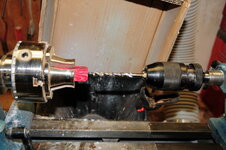For what it's worth, this is how I've solved my drilling issue. When I started on pens (that would be before I was hooked) I had more than a few split blanks using my drill press and a regular vise. I changed to using my lathe with the Vicmarc chuck and Long Nose jaws, after reading about this technique here in the forum.
About 250 slimlines later, I've only split one blank and it was a weird trustone sample I was given. I use a Dewalt Extreme 2 drill which has a bullet nose, very similar to a centering drill used on a metal lathe. The chuck comes from JohnyCNC, and is excellent. I haven't had it spin in the taper, but I do seat it with considerable force and make sure the taper surfaces are very clean. The long nose jaws are perfect for square and round blanks, but other shapes need a bit of juggling to get them in the centre. If I've cut the blank too far off square, or is out of the side of a log, I turn it to a cylinder between centres before drilling. This method gets me the centre exactly where I want it to be.
The only issue I have with this setup is that my tailstock travel isn't long enough to drill a blank in one pass. I have to back the tailstock shaft fully back after half drilling, then move the tailstock forward so the drill is part buried in the blank and continue drilling. But I'm backing the drill out the hole often to reduce heat buildup, so moving the tailstock during one of "backouts" isn't much of an issue at all. I'm real happy with this setup.

